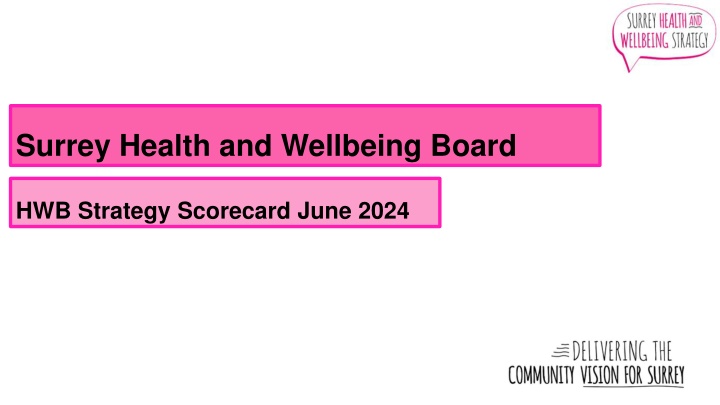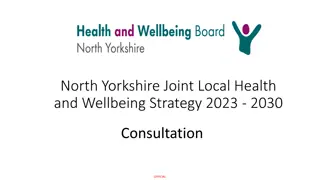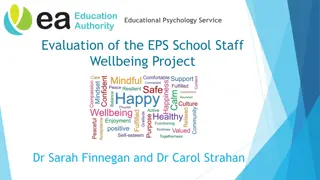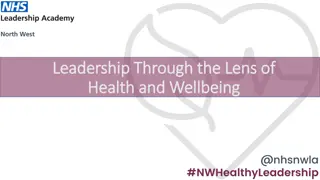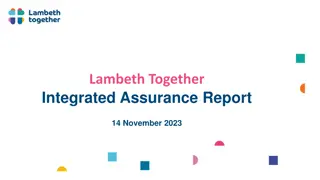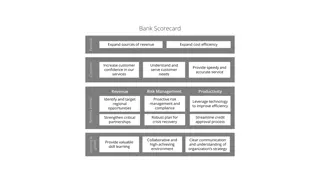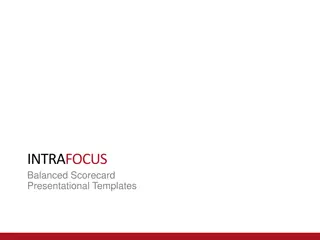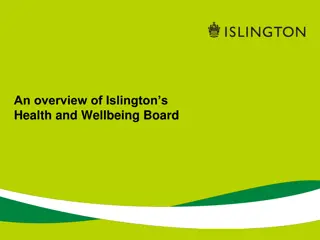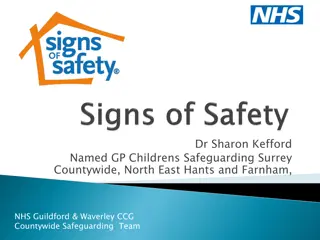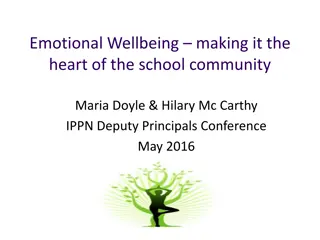Surrey Health and Wellbeing Board Strategy Scorecard Summary
The Surrey Health and Wellbeing Strategy was refreshed in response to COVID-19 to focus on reducing health inequalities and community capacity building for a Community Vision in 2030. The Health and Wellbeing Strategy Index measures progress against priorities and outcomes at different geographic levels utilizing various health indicators. The Strategy Scorecard offers a comprehensive overview of progress, highlighting areas needing improvement at county and local levels. Overarching indicators like Life Expectancy at Birth indicate a slight downward trend in life expectancy in Surrey compared to regional averages.
Download Presentation

Please find below an Image/Link to download the presentation.
The content on the website is provided AS IS for your information and personal use only. It may not be sold, licensed, or shared on other websites without obtaining consent from the author.If you encounter any issues during the download, it is possible that the publisher has removed the file from their server.
You are allowed to download the files provided on this website for personal or commercial use, subject to the condition that they are used lawfully. All files are the property of their respective owners.
The content on the website is provided AS IS for your information and personal use only. It may not be sold, licensed, or shared on other websites without obtaining consent from the author.
E N D
Presentation Transcript
Surrey Health and Wellbeing Board HWB Strategy Scorecard June 2024
The Health and Wellbeing Strategy The Surrey Health and Wellbeing Strategy was refreshed in early 2022 in response to COVID-19, to ensure it had a greater focus on reducing health inequalities, so no-one is left behind. In the refreshed Strategy there was also a commitment to community capacity building, co-designing and co- producing responses to problems, and community led action; these principles for working with communities are crucial to our success. Delivering the Strategy continues to play a crucial role in achieving the 'Community Vision for Surrey in 2030 .The strategy is published on the Healthy Surrey website. Partners in Surrey are measuring the long-term impact of the Health and Wellbeing Strategy on reducing health inequalities in Surrey using the Health and Wellbeing Strategy Index. The purpose of the Index is to measure progress against the Health and Wellbeing Strategy s Priorities, Outcomes, and meeting the needs of our Priority Populations (including the Key Neighbourhoods), where the data is available. The Index combines appropriate physical, mental and wider determinants of health indicators into baskets at different geographic levels. These allow us to see improvements that come from working together in partnership. The Index is calculated on an annual basis but not all data is from the same year; the most recent data available is used for each indicator. Alongside the Index are overarching indicators around life expectancy, healthy life expectancy and inequality in life expectancy, and indicators currently available for some of the Priority Populations at a Surrey-wide level. These indicators and the Index are presented in an interactive dashboard available on the surrey-i website.
The Health and Wellbeing Strategy Scorecard This Scorecard presents a simple to read summary of the findings in the HWB Strategy Index, outlining overall progress against the HWB Strategy to help gauge system-wide success (or otherwise) and support the direction of appropriate interventions related to the Priority Populations and Outcomes in the HWB Strategy where improvement is required. The Index section helps us understand needs at a place level and is currently published at a borough and district, Primary Care Network and ward level geographies, but this Scorecard also includes indicators for the whole county to present a Surrey-wide picture of progress. The first results presented on the Scorecard are the published overarching indicators, which are a measure of the long-term impact of the Strategy. This is followed by results published for indicators for some of our Priority Populations of identity, where data is available. Both these sets of indicators are published at a county level to present a Surrey-wide picture. The results published at a borough and district, Primary Care Network and ward level geographies* then follow and present progress against the HWB Strategy's Outcomes, grouped by the three Priorities. These help us understand progress and compare need at a more local level. Note: A borough/district or PCN which is ranked in the bottom three on the overall Index is highlighted in orange text. HWB Strategy Key Neighbourhoods are highlighted in pink text.
Overarching Indicators: Life Expectancy at Birth Life expectancy at birth is a measure of how long a person will live in years. For males and females in Surrey life expectancy is better than the regional average. The recent trend is downwards however, with a reduction of 0.62 years life expectancy for females between 2017-19 and 2020-22, and 0.82 years for males over the same period. This is a reversal of the longer-term upward trend and mirrors the regional picture. 2014-16 2015-17 2016-18 2017-19 2018-20 2019-21 2020-22 84 83.98 84.06 84.21 84.61 84.75 85.05 85.27 80.54 80.51 80.57 80.7 81.38 81.4 81.63 81.96 Change from previous reporting period 84.07 84.97 80.48 81.5 83.94 84.74 80.22 81.28 83.84 84.65 80.12 81.14 South East (female) Surrey (female) South East (male) Surrey (male) Good to be high Increase Decrease
Overarching Indicators: Inequality in Life Expectancy at Birth Inequality in life expectancy at birth is a measure of the difference in life expectancy in years between someone living in the most deprived decile in the county and someone living in the least deprived decile. This inequality is lower in Surrey for both males and females compared to the region and has fluctuated up and down by small margins over the past few years. There has been a 1-year increase in inequality since 2014-16 for females and 0.8-year increase for males over the same period. The longer-term trend in Surrey is an increase in inequality for females but no change for males. Change from previous reporting period 2010-12 7.5 6.2 5.3 4.3 2011-13 7.6 6.1 5.4 4.6 2012-14 7.5 6 5.5 4.7 2013-15 7.8 5.9 5.5 4.7 2014-16 7.8 5.6 5.7 4.4 2015-17 8 5.9 5.9 4.6 2016-18 7.9 5.8 6 4.7 2017-19 7.8 6.1 6.1 5.3 2018-20 7.9 6.2 6 5.4 South East (male) Surrey (male) South East (female) Surrey (female) Increase Good to be low Decrease No Change
Overarching Indicators: Healthy Life Expectancy at Birth Healthy life expectancy at birth is a measure of the average number of years a person would expect to live from birth in good health. This is better for males and females in Surrey than the regional average. There has been some notable fluctuation in the past few years, with some strong increases followed by reductions. There was a spike in healthy life expectancy for females between 2014-16 and 2017-19, where it increased by 3.2 years from 2014-16 to 2016-18 before falling again. Conversely, males experienced a gentle decline in this period, with healthy life expectancy falling 1.6 years between 2014-16 and 2017-19. The most recent trend in the available data is upwards, with an increase of 0.6 years healthy life expectancy for males and 0.3 years for females in Surrey between 2017-19 and 2018- 20. Change from previous reporting period 2010-12 65.5 68.1 67 68.6 2011-13 65.4 68 66.4 69.5 2012-14 65.9 67.4 66.4 68.9 2013-15 65.9 68.6 66.7 68.7 2014-16 66.1 68.8 66.3 68 2015-17 66.1 68.3 66.2 68.7 2016-18 65.6 68.6 66.9 71.2 2017-19 65.3 67.2 65.9 69.4 2018-20 65.5 67.8 65.9 69.7 South East (male) Surrey (male) South East (female) Surrey (female) Increase Good to be high Decrease No Change
Priority Populations: Adult Carers with Enough Social Contact This is a measure of the percentage of adult carers (aged 18+) who have as much social contact as they would like. Surrey has generally performed below the national average on this survey-based measure, although Surrey has gone against the continued downward trend seen regionally and nationally to be slightly above the national average in 2021-22 (this difference is reported as being not statistically significant). O Change from previous reporting period 2012-13 2014-15 2016-17 2018-19 2021-22 41.4 38.5 35.5 37.7 35.5 33.2 35.9 35.8 28 32.5 31.4 22.4 28 27.9 30.9 England South East Surrey Good to be high Increase Decrease
Priority Populations: Adult Social Care Users with Enough Social Contact This is a measure of the percentage of adult social care service users (aged 18+) who have as much social contact as they would like. Surrey has generally performed above the national average on this survey-based measure, although the difference is not statistically significant, and has followed the trend seen regionally and nationally. This has included a gradual increase in the percentage of Adult Social Care users who have as much social contact as they would like since 2010, but is marked by a recent decline, particularly during the Covid-19 pandemic. The performance shows signs of recovery in 2022-23 however. O Change from previous reporting period 2010-11 2011-12 2012-13 2013-14 2014-15 2015-16 2016-17 2017-18 2018-19 2020-21 2021-22 2022-23 41.9 42.3 43.2 44.5 44.8 45.4 41.2 41.4 43.9 45.3 47.1 46.8 42.8 43.5 42.9 49.4 44.1 46.4 Increase England South East Surrey 45.4 46.6 47.0 46.0 47.0 49.2 45.9 47.8 48.9 45.9 45.5 47.3 40.6 40.7 40.8 44.4 45.2 46.2 Good to be high Decrease No change
Priority Populations: Employment Gap for Adults with a Learning Disability This is a measure of the percentage gap in the employment rate between those who are in receipt of long-term support for people with a learning disability (aged 18 to 64) registered with adult social care and the overall employment rate. For example, if 80% of the wider population is employed compared to 10% of adults with a learning disability, the gap is 70%. Surrey has moved from performing roughly in line with or worse than the national average on this measure, to performing better than the national and regional average (and a statistically significant difference). The current employment gap of 67.5% is bigger than the lowest point seen in the trend (65% in 2012-13) but has narrowed since 2018-19 (when it was 72.4%) by almost 5%. Change from previous reporting period 2012-13 64 64.7 65 2013-14 65 67.4 66.6 2014-15 66.9 68.7 68.7 2015-16 68.1 71 70 2016-17 68.7 71.6 72.3 2017-18 69.2 72 68.7 2018-19 69.7 72 72.4 2019-20 70.6 72.7 68 2020-21 70 71.1 67.5 2021-22 70.6 71.5 67.5 Increase England South East Surrey Good to be low Decrease No Change
Priority Populations: Adults with a Learning Disability Living in Stable and Appropriate Accommodation This is a measure of the percentage of adults (aged 18 to 64) with a learning disability registered with adult social care who are living in stable and appropriate accommodation as a percentage of adults with a learning disability. Surrey is performing 3% worse than the national average, .9% worse that the regional on this measure, despite the percentage increase of 18.1% since 2018-19. O Change from previous reporting period 2013-14 74.9 70.6 67.7 2014-15 74 68.4 64.2 2015-16 75.4 70.2 67.7 2016-17 76.2 71.3 65.9 2017-18 77.2 72.8 66.4 2018-19 77.4 70.7 59.3 2019-20 77.3 71.8 68.1 2020-21 78.3 75.6 73.4 2021-22 78.7 76.2 75.2 2022-23 80.5 78.3 77.4 Increase England South East Surrey Good to be high Decrease No Change
Priority Populations: Employment Gap for Adults in Contact with Secondary Mental Health Services This is a measure of the percentage gap in the employment rate between those who are in contact with secondary mental health services (aged 18 to 69) and the overall employment rate (aged 16-64). For example, if 80% of the wider population is employed compared to 10% of adults in contact with secondary mental health services, the gap is 70%. This indicator was previously the employment gap for adults in contact with secondary mental health services and on the Care Programme Approach (CPA) but changed in 2021-22 to be all those contact with secondary mental health services because the CPA was superseded by the Community Mental Health Framework. Since 2018-2019, Surrey's progress has been significantly worse compared to nationally and regionally and is over 8% worse compared to both on the new indicator. Change from previous reporting period 2013-14 64.7 68.9 71 2014-15 66.1 69.5 68.3 2015-16 67.2 70.5 72.3 2016-17 67.4 69.7 68.5 2017-18 68.2 70.5 65.7 2018-19 67.6 69.4 70.7 2019-20 67.2 70.6 71.3 2020-21 66.1 66.7 71.1 2021-22 69.4 70.1 78.2 2011-12 61.3 66.5 69.5 2012-13 62.2 65.4 68.1 Increase England South East Surrey Good to be low Decrease No Change New Definition
Priority Populations: Adults in Contact with Secondary Mental Health Services in Stable and Appropriate Accommodation This is a measure of the percentage of adults who are receiving secondary mental health services on the Care Programme Approach (CPA) recorded as living independently, with or without support, out of all adults who are receiving secondary mental health services and are on the CPA (aged 18 to 69). There has been some notable fluctuation in the past few years, with a 31.4% increase from 2015-16 to 2017-18, followed by a 23.0% reduction to the current reporting period of 2020-21. Surrey s current progress is 13% worse than the regional average and 10% worse than the national average. Change from previous reporting period 2011-12 54.6 42.7 43.5 2012-13 58.5 56.3 44.4 2013-14 60.8 51.5 41.7 2014-15 59.7 51.0 45.3 2015-16 58.6 48.2 39.6 2016-17* 54.0 45.0 64.0 2017-18 57.0 48.0 71.0 2018-19 58.0 56.0 58.0 2019-20 58.0 52.0 55.0 2020-21 58.0 61.0 48.0 Increase England South East Surrey Good to be high Decrease No Change * There is a reported data quality issue with this value
Priority 1: Supporting People to Lead Healthy Lives by Preventing Physical Ill Health and Promoting Physical Wellbeing Outcome 1: People Have a Healthy Weight and are Active Change from previous Surrey result Latest Primary Care Network result Good to be Latest Surrey result Latest Borough and District result Latest Ward result Indicator Best: Godalming Charterhouse (Waverley) 12.0% Worst: Stanwell Stanwell North North (Spelthorne) 30.7%* * Adults who are physically active (doing at least 150 minutes of moderate intensity activity in the past week) Best: Elmbridge 74.9% Worst: Epsom and Ewell 62.3% +3.1 +3.1 66.8% 69.9% Data not available at this geography High High (Nov 2021-22) (Nov 2020-21) Adults who are physically inactive (doing less than 30 minutes of moderate intensity activity in the past week) Best: Holy Trinity (Guildford) 77.4% Worst: Stanwell Stanwell North North (Spelthorne) 55.2%* * Best: Tandridge 16.3% Worst: Epsom and Ewell 22.8% - - 1.6 1.6 21.1% 19.5% Data not available at this geography Low Low (Nov 2021-22) (Nov 2020-21) Children who are physically active (doing an average of 60+ minutes of moderate intensity activity per day) - -2.8 2.8 48.9% Best: Mole Valley 55.0% Worst: Surrey Heath 36.0% 46.1% (Academic Year 2022-23) Data not available at this geography Data not available at this geography High High (Academic Year 2021- 22) Proportion of residents who reported eating five or more portions of fruit and/or vegetables yesterday** 39.5% (April December 2023) Best: Epsom and Ewell 47.8% Worst: Spelthorne Spelthorne 26.8% Trend data not currently available Data not available at this geography Data not available at this geography High High Change from previous reporting period Decline Improvement *These are modelled estimates ** Responses to the Joint Neighbourhood Survey No Change
Priority 1: Supporting People to Lead Healthy Lives by Preventing Physical Ill Health and Promoting Physical Wellbeing Outcome 2: Substance Misuse is Low (page 1 of 2) Change from previous Surrey result Latest Primary Care Network result Good to be Latest Surrey result Latest Borough and District result Latest Ward result Indicator Admission episodes for alcohol-related conditions (standardised rate per 100,000) Best: Epsom and Ewell 1,287 Worst: Spelthorne Spelthorne 1,888 +251 1,260 (2020-21) 1,511 (2021-22) Data not available at this geography Data not available at this geography Low Low Best: Hinchley Wood and Weston Green (Elmbridge) 51.54** Worst: Stoke (Guildford) 146.30** Hospital admissions for alcohol attributable harm (standardised emergency admission ratio - SAR)* Best: Elmbridge 71.51 Worst: Guildford 96.98 Best: East Elmbridge 70.43** Worst: GRIPC 111.65** Only one reporting period is available for this indicator 83.83 Low Low (2016 to 19) Stoke Best: Guildford 1.3 Worst: Woking Woking 3.3 Deaths from drug misuse (standardised rate per 100,000) 2.5 No change 2.5 (April 17- March 19) Data not available at this geography Data not available at this geography Low Low (April 2018- March 20) Change from previous reporting period * This is an old indicator which has been replaced by a new reporting method. The SAR is a ratio of the actual number of emergency admissions in the area to the number expected if the area had the same age specific admission rates as England, multiplied by 100. An SAR of 100 indicates that the area has average emergency admission rate, higher than 100 indicates that the area has higher than average emergency admission rate, lower than 100 indicates lower than average emergency admission rate. ** These are custom area rates aggregated from MSOA averages. Decline Improvement No Change
Priority 1: Supporting People to Lead Healthy Lives by Preventing Physical Ill Health and Promoting Physical Wellbeing Outcome 2: Substance Misuse is Low (page 2 of 2) Change from previous Surrey result Latest Primary Care Network result Good to be Latest Surrey result Latest Borough and District result Latest Ward result Indicator Best: Reigate and Banstead 5.6% Worst: Surrey Heath 6.6% - -0.1 0.1 5.8% (2021-22) Smoking status at the time of delivery* 5.7% (2022-23) Data not available at this geography Data not available at this geography Low Low Best: Mole Valley 11.2% Worst: Runnymede Runnymede 35.4% Smoking prevalence in adults (18+) with long term mental health conditions +2.0 +2.0 20.0% (2021-22) 22.0% (2022-23) Data not available at this geography Data not available at this geography Low Low Smoking prevalence in adults (18-64) in routine and manual occupations +10.4 +10.4 19.6% (2021) Data not available for all areas at this geography 30.0% (2022) Data not available at this geography Data not available at this geography Low Low Change from previous reporting period Decline * The number of mothers known to be smokers at the time of delivery as a percentage of all maternities with known smoking status. A maternity is defined as a pregnant woman who gives birth to one or more live or stillborn babies of at least 24 weeks gestation, where the baby is delivered by either a midwife or doctor at home or in an NHS hospital Improvement No Change
Priority 1: Supporting People to Lead Healthy Lives by Preventing Physical Ill Health and Promoting Physical Wellbeing Outcome 4: Serious conditions and diseases are prevented (page 1 of 2) Change from previous Surrey result Latest Borough and District result Good to be Latest Surrey result Latest Primary Care Network result Indicator Latest Ward result Proportion of people with learning disabilities (aged 14+) having complete range of physical health checks in the 12 last months Best: Surrey Heath 86.7% Worst: Elmbridge 56.8% Data not currently available at this geography 80.2% Trend data not currently available Data not available at this geography High High (February 2024) Best: South Tandridge 82.1 Worst: SASSE Network 3 122.9 Best: Farnham Bourne (Waverley) 45.5 Worst: Walton North Walton North (Elmbridge) 154.5 - -0.1 0.1 10.5 Under 75 mortality rate from colorectal cancer (all persons)* 10.4 Best: Elmbridge 7.4 Worst: Woking Woking 14.2 Low Low (2020-22) (2019-21) Best: Banstead Healthcare 81.2 Worst: SASSE Network 2 125.1 Best: Beare Green (Mole Valley) 50.7 Worst: Lovelace (Guildford) 205.4 Best: Guildford 13.6 Worst: Woking Woking 25.6 - -0.9 0.9 18.6 Under 75 mortality rate from breast cancer (females)* 17.5 Low Low (2020-22) (2019-21) Best: East Elmbridge 94.8 Worst: COCO 138.9 Best: Ewhurst (Waverley) 25.2 Worst: Okewood (Mole Valley) 137.9 - -0.1 0.1 102.0 (2019-21) Under 75 mortality rate from cancer (all persons)** 101.9 (2020-22) Best: Elmbridge 92.9 Worst: Woking Woking 112.7 Low Low * Results for PCNs and Wards show the number of new cases of cancer, not deaths under 75. Figures are presented as indirectly age-sex standardised registration ratios (number of new cases as a percentage of expected new cases), calculated relative to England, for 2012-15. ** Results presented for PCNs and Wards are the age standardised estimates of deaths from all cancers for people aged under 75 (standardised mortality ratio) for 2016-19. The ratio is calculated by dividing the observed total deaths in the area by the expected deaths (applying age-specific death rates for England) and multiplying by 100. A score of 100 means the observed deaths are as expected.
Priority 1: Supporting People to Lead Healthy Lives by Preventing Physical Ill Health and Promoting Physical Wellbeing Outcome 4: Serious conditions and diseases are prevented (page 2 of 2) Change from previous Surrey result Latest Borough and District result Good to be Latest Surrey result Latest Primary Care Network result Indicator Latest Ward result Best: Oxshott and Stoke D Abernon (Elmbridge) 3.82% Worst: Stanwell Stanwell North North (Spelthorne) 8.83% Best: East Elmbridge 4.52% Worst: SASSE Network 1 Network 1 7.5% Best: Elmbridge 4.84% Worst: Spelthorne Spelthorne 7.52% 6.02% (April 2022 March 23) +0.4 +0.4 5.8% Diabetes prevalence Low Low SASSE (April 2021 March 22) Best: Epsom and Ewell 2,562 Worst: Mole Valley 745 +420 +420 1,361 (2022) Chlamydia detection rate (per 100,000 females aged 15 to 24)* 1,781 (2023) Data not available at this geography Data not available at this geography High High Best: GRIPC 10.5% Worst: Banstead Healthcare 16.1% Best: Guildford 11.8% Worst: Mole Valley 15.8% 13.6% (April 2022 March 23) +0.5 +0.5 13.1% Hypertension prevalence (all ages) Data not available at this geography Low Low (April 2021 March 22) Best: West Byfleet 85.9% Worst: Woking Wise 75.9% MMR vaccination (proportion of children receiving two doses aged 5)** 83.5% (April 2022 March 23) - -0.4 0.4 83.9% Data to follow in future update Data not available at this geography High High (April 2021 March 22) Change from previous reporting period Decline * The chlamydia detection rate among under 25-year-olds is a measure of chlamydia control activity, aimed at reducing the incidence of reproductive sequelae of chlamydia infection and interrupting transmission. An increased detection rate is indicative of increased control activity; the detection rate is not a measure of morbidity ** PCN level data is for January to December 2023 Improvement No Change
Priority 1: Supporting People to Lead Healthy Lives by Preventing Physical Ill Health and Promoting Physical Wellbeing Outcome 5: People are supported to live well independently for as long as possible Change from previous Surrey result Latest Primary Care Network result Good to be Latest Surrey result Latest Borough and District result Latest Ward result Indicator Best: Surrey Heath 1.3 Worst: Elmbridge 9.7 Emergency hospital admission rates of people with dementia* 5.2 +0.2 +0.2 5.0 Data not available at this geography Data not available at this geography Low Low (April 2022 March 23) (April 2021 March 22) Change from previous reporting period Decline * The rate of people admitted to hospital emergency departments for any reason who have dementia (per 1,000 of the population) Improvement No Change
Priority 2: Supporting Peoples Mental Health and Emotional Wellbeing by Preventing Mental Ill Health and Promoting Emotional Wellbeing Outcome 1: Adults, children and young people at risk of and with depression, anxiety and other mental health issues access the right early help and resources (page 1 of 2) Change from previous Surrey result Latest Borough and District result Good to be Latest Surrey result Latest Primary Care Network result Indicator Latest Ward result Best: Woking 2.76 Worst: Spelthorne Spelthorne 5.16 3.36 +0.42 +0.42 2.94 Average anxiety score (out of 10)* Data not available at this geography Data not available at this geography Low Low (April 2022 March 23) (April 2021 March 22) Best: Mole Valley 8.46 Worst: Spelthorne Spelthorne 6.61 7.75 - -0.10 0.10 7.85 Average feeling worthwhile score (out of 10)* Data not available at this geography Data not available at this geography High High (April 2022 March 23) (April 2021 March 22) 7.62 +0.04 +0.04 7.58 Best: Woking 8.21 Worst: Spelthorne Spelthorne 7.2 Average life satisfaction score (out of 10)* Data not available at this geography Data not available at this geography High High (April 2022 March 23) (April 2021 March 22) Best: Surrey Heath 7.89 Worst: Reigate and Banstead 7.07 +0.09 +0.09 7.39 7.48 Average happiness (out of 10)* Data not available at this geography Data not available at this geography High High (April 2022 March 23) (April 2021 March 22) Suicides (standardised rate per 100,000 persons aged 10+)** - -0.5 0.5 10.0 Best: Spelthorne Spelthorne 5.6 Worst: Mole Valley 13.7 9.5 Data not available at this geography Data not available at this geography Low Low (2020-22) (2019-21) Change from previous reporting period Decline * Some of the data at borough level for this indicator is considered unreliable **Age-standardised mortality rate from suicide and injury of undetermined intent per 100,000 population. Data source is Office for National Statistics Annual Mortality Extract (produced for OHID) and accessed via Public Health Fingertips Improvement No Change
Priority 2: Supporting Peoples Mental Health and Emotional Wellbeing by Preventing Mental Ill Health and Promoting Emotional Wellbeing Outcome 1: Adults, children and young people at risk of and with depression, anxiety and other mental health issues access the right early help and resources (page 2 of 2) Change from previous Surrey result Latest Borough and District result Good to be Latest Surrey result Latest Primary Care Network result Indicator Latest Ward result Access to Community Mental Health Services for adults and older adults with serious mental illness 21,885 (March 2023 February 2024) +2,920 +2,920 18,965 Data to follow in future update Data to follow in future update Data not available at this geography High High (May 2022 April 2023) Number of young people aged under 18 supported through NHS funded mental health with at least one contact +560 +560 22,570 23,135 (March 2023 February 2024) Data to follow in future update Data to follow in future update Data not available at this geography High High (May 2022 April 2023) Patients who felt the healthcare professional recognised or understood any mental health needs during their last general practice appointment Best: West of Waverley 91.7% Worst: SASSE Network 3 Network 3 75.6% 84.7% (2023) Data to follow in future update Data to follow in future update Data not available at this geography High High SASSE Proportion of people with serious mental illness having complete range of physical health checks in the 12 last months +11.9 +11.9 51.5% 63.4% (April 2022- March 2023) Data to follow in future update Data to follow in future update Data not available at this geography High High (April 2021 March 2022) Best: Woking Wise 0.56% Worst: Care Collaborative (Redhill) 0.95% Change from previous reporting period +0.03 +0.03 0.74% Proportion of patients on the GP register with mental health issues (all ages)* 0.77% (April 2022- March 2023) Data to follow in future update Data not available at this geography Neutral Neutral Decline (April 2021 March 2022) Improvement No Change * The percentage of patients with schizophrenia, bipolar affective disorder and other psychoses as recorded on practice disease registers. Quality and Outcomes Framework (QOF), NHS England
Priority 2: Supporting Peoples Mental Health and Emotional Wellbeing by Preventing Mental Ill Health and Promoting Emotional Wellbeing Outcome 2: The emotional well-being of parents and caregivers, babies and children is supported Change from previous Surrey result Latest Borough and District result Good to be Latest Surrey result Latest Primary Care Network result Indicator Latest Ward result The proportion of school pupils receiving special educational needs support whose primary need is social, emotional and mental health Data not currently available at this geography Data not currently available at this geography Data not currently available at this geography 22.5% (June 2024) Trend data not currently available The proportion of school pupils with an EHCP whose primary need is social, emotional and mental health Data not currently available at this geography Data not currently available at this geography Data not currently available at this geography 16.9% (June 2024) Trend data not currently available Proportion of children receiving a 12-month review with their Health Visitor +7.9 +7.9 61.5% Data not currently available at this geography Data not currently available at this geography Data not currently available at this geography 69.4% High High (March 2024) (December 2023) Proportion of children receiving 2-and-a-half-year check with their Health Visitor - -6.3 6.3 70.5% 64.2% Data not currently available at this geography Data not currently available at this geography Data not currently available at this geography High High (January-March 2024) (October-December 2023) Change from previous reporting period Decline Improvement No Change
Priority 2: Supporting Peoples Mental Health and Emotional Wellbeing by Preventing Mental Ill Health and Promoting Emotional Wellbeing Outcomes 3: Isolation is prevented and those that feel isolated are supported Change from previous Surrey result Latest Borough and District result Good to be Latest Surrey result Latest Primary Care Network result Indicator Latest Ward result Best: Epsom and Ewell 85.1% Worst: Spelthorne Spelthorne 64.5% In my local area there are place people can meet up and socialise* 76.7% (April Trend data not currently available Data not available at this geography Data not available at this geography High High December 2023) If I needed help, there are people in the local area who would be there for me* 79.2% (April Best: Surrey Heath 86.5% Worst: Woking Woking 72.5% Trend data not currently available Data not available at this geography Data not available at this geography High High December 2023) Change from previous reporting period Decline * Responses to new Joint Neighbourhood Survey Improvement No Change
Priority 2: Supporting Peoples Mental Health and Emotional Wellbeing by Preventing Mental Ill Health and Promoting Emotional Wellbeing Outcomes 4: Environments and communities in which people live, work and learn build good mental health Change from previous Surrey result Latest Borough and District result Good to be Latest Surrey result Latest Primary Care Network result Indicator Latest Ward result Best: Mole Valley 89.1% Worst: Spelthorne Spelthorne 72.2% 81.1% (April I feel like I belong to my local area* Trend data not currently available Data not available at this geography Data not available at this geography High High December 2023) Proportion of residents doing any unpaid work to help their community or the people who live in it in the last year* Best: Waverley 46.2% Worst: Spelthorne Spelthorne 33.0% 37.8% (April Trend data not currently available Data not available at this geography Data not available at this geography High High December 2023) Change from previous reporting period Decline * Responses to new Joint Neighbourhood Survey Improvement No Change
Priority 3: Supporting People to Reach Their Potential by Addressing the Wider Determinants of Health Outcome 1: People's basic needs (food security, poverty, housing) are met (page 1 of 2) Change from previous Surrey result Latest Borough and District result Good to be Latest Surrey result Latest Primary Care Network result Indicator Latest Ward result Best: Woldingham (Tandridge) 0.9% Worst: Canalside Canalside (Woking) 28.4% Best: Elmbridge 6.9% Worst: Woking Woking 12.6% Best: Guildford East 5.57% Worst: Woking Wise 2 14.47% Proportion of children (aged 0-19) in relative low-income families 9.5% +0.1 +0.1 9.4% Low Low (April 2021 March 22) (April 2020 March 21) Best: Four areas# report 5% Worst: Westborough Westborough (Guildford) 15% Best: Five areas* report 7% Worst: Four areas** report 10% +1 +1 7.3% (2021) Best: Surrey Heath 6.8% Worst: Waverley 9.3% Proportion of households in fuel poverty 8.3% (2022) Low Low Best: Surrey Heath 3.9 Worst: Spelthorne Spelthorne 9.2 7.0 +0.2 +0.2 6.8 Rate of households owed a homelessness duty Data not available at this geography Data not available at this geography Low Low (April 2022 March 23) (April 2021 March 22) Change from previous reporting period Decline * COCO, Surrey Heath, West Byfleet, Woking Wise 1 and Woking Wise 3 PCNs ** Central and North Guildford, Dorking, South Tandridge and West of Waverley PCNs # Burpham (Guildford), Horley East and Salfords (Reigate and Banstead), Heatherside (Surrey Heath) and St. Paul s (Surrey Heath) Improvement No Change
Priority 3: Supporting People to Reach Their Potential by Addressing the Wider Determinants of Health Outcome 1: People's basic needs (food security, poverty, housing) are met (page 2 of 2) Change from previous Surrey result Latest Borough and District result Good to be Latest Surrey result Latest Primary Care Network result Indicator Latest Ward result Best: Woking Woking 13.4% Worst: Reigate and Banstead 21.9% Proportion of residents who have struggled to pay any essential bills in the last 6 months?* 16.4% (April Trend data not currently available Data not available at this geography Data not available at this geography Low Low December 2023) Proportion of residents who have had to access a food bank or community food provision in the last 6 months?* Best: Tandridge 5.1% Worst: Spelthorne Spelthorne 23.8% 14.4% (April Trend data not currently available Data not available at this geography Data not available at this geography Low Low December 2023) Proportion of residents who have had to access additional borrowing (e.g. loans or credit cards) in the last 6 months?* Best: Waverley 20.5% Worst: Spelthorne Spelthorne 38.1% 30.4% (April Trend data not currently available Data not available at this geography Data not available at this geography Low Low December 2023) Change from previous reporting period Decline * Responses to new Joint Neighbourhood Survey Improvement No Change
Priority 3: Supporting People to Reach Their Potential by Addressing the Wider Determinants of Health Outcome 2: Children, young people and adults are empowered in their communities Change from previous Surrey result Latest Borough and District result Good to be Latest Surrey result Latest Primary Care Network result Indicator Latest Ward result Attainment gap between non- /disadvantaged pupils: Early years foundation stage good level of development* Best: Tandridge 16.4% Worst: Mole Valley 33.7% 27.3% (2023) Trend data not currently available Data not available at this geography Data not available at this geography Low Low Best: Reigate and Banstead 24.7% Worst: Waverley 38.4% Attainment gap between non- /disadvantaged pupils: Key stage 2 reading, writing and maths* 31.8% (2023) Trend data not currently available Data not available at this geography Data not available at this geography Low Low Best: Tandridge 14.0% Worst: Surrey Heath 25.4% Attainment gap between non- /disadvantaged pupils: Key stage 4 (attainment 8 score)* 20.3% (2023) Trend data not currently available Data not available at this geography Data not available at this geography Low Low Proportion of residents who would be willing to work with others to improve their local area** Best: Elmbridge 85.4% Worst: Woking Woking 76.6% 79.5% (April Trend data not currently available Data not available at this geography Data not available at this geography High High December 2023) Change from previous reporting period Decline Improvement * For example, if 76% of non-disadvantaged pupils attain a good level of early years development, compared to 49% of disadvantaged pupils, the gap is 27%. Disadvantage includes looked after children, adopted children and children eligible for Free School Meals in the last 6 years. Children with an EHCP are not included unless they meet the above criteria. ** Responses to new Joint Neighbourhood Survey No Change
Priority 3: Supporting People to Reach Their Potential by Addressing the Wider Determinants of Health Outcome 3: People access training and employment opportunities within a sustainable economy Change from previous Surrey result Latest Borough and District result Good to be Latest Surrey result Latest Primary Care Network result Indicator Latest Ward result Best: numerous Wards at 0.0% Worst: Longcross, Lyne and Chertsey South (Runnymede) 1.8% Best: numerous PCNs at 0.0% Worst: GRIPC 0.04% 0.0% - -0.1 0.1 0.1% Job seekers claimants claiming for over 12 months* All boroughs are either 0.0 or 0.1% Low Low (April 2022 March 23) (April 2021 March 22) Best: Englefield Green East (Runnymede) 0.4% Worst: Stanwell Stanwell North North (Spelthorne) 4.9% Best: Guildford East 1.4% Worst: SASSE Network 3 Network 3 3.7% Unemployment benefit (Jobseekers Allowance and out of work Universal Credit claimants)* Best: Waverley 1.7% Worst: Spelthorne Spelthorne 2.9% 2.0% - -0.8 0.8 2.8% Low Low (April 2022 March 23) SASSE (April 2021 March 22) Best: Guildford East 1.2% Worst: SASSE SASSE Network 3 Network 3 5.4% Best: Youth unemployment (young people aged 18-24 receiving Jobseekers Allowance or Universal Credit)** Best: Guildford 1.4% Worst: Spelthorne Spelthorne 4.1% 12 Wards at 0.0% Worst: Egham Hythe (Runnymede) 7.0% 1.81% (April 2022 March 23) - -1.6 1.6 2.87% Low Low (April 2021 March 22) Proportion of young people aged 16 18 participating in training, education or employment Data not currently available at this geography 75.4% (June 2024) Trend data not currently available Data to follow in future update Data not available at this geography High High Change from previous reporting period Decline Improvement * Proportion of the resident population aged 16+ ** Proportion of the resident population aged 18-24 No Change
Priority 3: Supporting People to Reach Their Potential by Addressing the Wider Determinants of Health Outcome 4: People are safe and feel safe Change from previous Surrey result Latest Borough and District result Good to be Latest Surrey result Latest Primary Care Network result Indicator Latest Ward result Best: Waverley 5.3 Worst: Runnymede Runnymede 9.1 8.3 - -1.5 1.5 9.8 Data not currently available at this geography Data not currently available at this geography Domestic abuse* Low Low (April 2022 March 23) (April 2021 March 22) Best: Black Heath and Wonersh (Waverley) 0.6 Worst: Holy Trinity (Guildford) 37.1 Best: West of Waverley 6.4 Worst: SASSE SASSE Network 3 Network 3 32.7 Best: Waverley 8.8 Worst: Spelthorne Spelthorne 18.6 13.1 - -3.1 3.1 16.2 Anti-social behaviour* Low Low (April 2022 March 23) (April 2021 March 22) Best: Shamley Green and Cranleigh North (Waverley) 1.6 Worst: Friary and St. Nicolas (Guildford) 66.8 Best: West of Waverley 12.8 Worst: SASSE SASSE Network 3 Network 3 23.4 Best: Waverley 17.3 Worst: Spelthorne Spelthorne 27.9 23.6 - -0.7 0.7 24.3 Violent and sexual offences* Low Low (April 2022 March 23) (April 2021 March 22) Best: Guildford 89.3% Worst: Epsom and Ewell 70.4% Proportion of residents who would feel safe walking alone after dark in their neighbourhood** 81.1% (April Trend data not currently available Data not available at this geography Data not available at this geography Change from previous reporting period High High December 2023) Decline Improvement * Rate of incidents and crimes per 1000 people in the population ** Responses to new Joint Neighbourhood Survey No Change
Priority 3: Supporting People to Reach Their Potential by Addressing the Wider Determinants of Health Outcome 5: The benefits of healthy environments for people are valued and maximised (page 1 of 2) Change from previous Surrey result Latest Borough and District result Good to be Latest Surrey result Latest Primary Care Network result Indicator Latest Ward result Best: Elmbridge 15.3% Worst: Four areas** report 0% +2.0 +2.0 6.1% Cycling at least once per month for travel* 8.1% Data not available at this geography Data not available at this geography High High (Nov 2022) (Nov 2021) Best: Epsom and Ewell 49.5% Worst: Surrey Heath 35.4% +8.4 +8.4 35.8% (Nov 2021) Walking at least once per month for travel** 44.2% (Nov 2022) Data not available at this geography Data not available at this geography High High Best: Westborough Westborough (Guildford) 22.3% Worst: Normandy (Guildford) 2.1% Best: GRIPC 15.2% Worst: Banstead Healthcare 4.3% Best: Guildford 10.1% Worst: Tandridge 5.0% - -3.4 3.4 10.8% Travel to work by bicycle or on foot*** 7.4% High High (Census 2021) (Census 2011) Best: Whyteleafe (Tandridge) 13.1% Worst: Alfold, Cranleigh Rural and Ellens Green (Waverley) 1.4% Best: Epsom and Ewell 8.4% Worst: Waverley 2.9% Best: Integrated Care Partnership 8.6% Worst: Farnham 2.5% - -11.2 11.2 16.8% 5.6% Travel to work by rail or bus*** High High (Census 2021) (Census 2011) Change from previous reporting period Decline * Active Lives Survey by Sport England ** Reigate and Banstead, Runnymede, Surrey Heath and Tandridge *** Proportion of people travelling to work as a percentage of the usual resident population aged 16+ Improvement No Change
Priority 3: Supporting People to Reach Their Potential by Addressing the Wider Determinants of Health Outcome 5: The benefits of healthy environments for people are valued and maximised (page 2 of 2) Change from previous Surrey result Latest Borough and District result Good to be Latest Surrey result Latest Primary Care Network result Indicator Latest Ward result Proportion of residents who report having avoided/minimised throwing away food in the last 6 months* Best: Elmbridge 94.1% Worst: Spelthorne Spelthorne 90.1% 91.8% (April Trend data not currently available Data not available at this geography Data not available at this geography High High December 2023) Best: Mole Valley 89.8% Worst: Epsom and Ewell 85.4% Proportion of residents who report having minimised the amount of energy used at home in the last 6 months* 87.9% (April Trend data not currently available Data not available at this geography Data not available at this geography High High December 2023) Change from previous reporting period Decline Improvement * Responses to new Joint Neighbourhood Survey No Change
